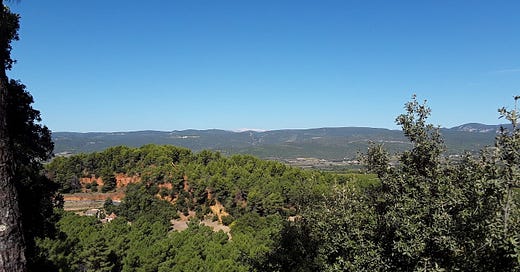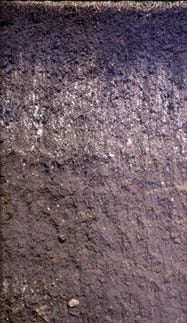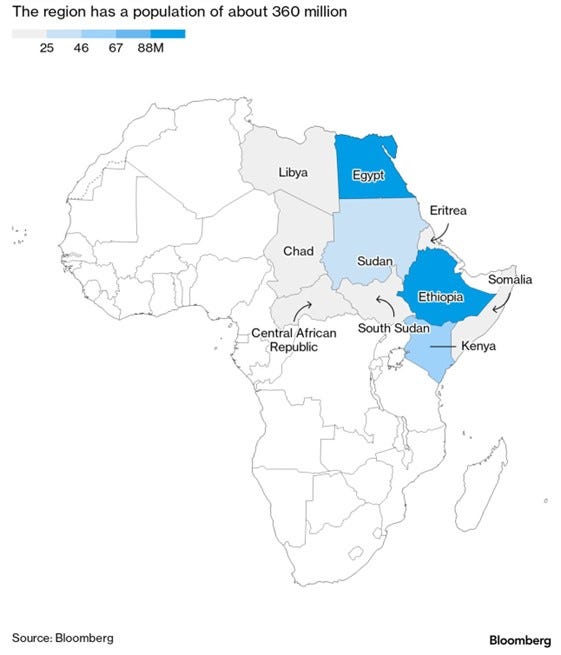Even though human factors such as technological inputs are increasingly influential in agriculture, the basic key physical environmental variables of climate and soils are still important for agriculture, and food supplies, on a large scale. In simple terms some places in the world are more suited for agriculture than others, largely because of the zonal soils they possess.
The following two sections examine areas where climate and soils are ideally suited to agriculture and food production: the Canadian Prairies and the Mediterranean regions of Europe. The third section highlights an area at risk of significant famine.
[A zonal soil is a type of soil that shows the maximum effect of climate and vegetation on soil formation. They are mature soils in that they have had time to develop with distinctive profiles, often with clear horizons (layering). Two examples are examined below: chernozems and Mediterranean brown or red earths.]
1. The Temperate Grasslands - the Canadian Prairies
In the mid-latitude continental interior of North America there are extensive areas of natural grassland. Much of this grassland has in the last two centuries been heavily modified by human activity and by farming. Large areas have been ploughed up for extensive wheat farming, and the rest is used for equally extensive cattle and sheep ranching. The natural relationship between climate and soils has greatly influenced the type of agriculture being undertaken here. It is also clear that due to the nature of the agricultural activity, both the numbers and density of people are low.
Climatically, the conditions are:
· the hottest months have temperatures between 27 and 21C, depending on latitude.
· the coolest months have temperatures between 0 and -4C.
· the annual range therefore is approximately 28-22C.
· rainfall totals are usually less than 500mm, with a summer maximum and some snow in winter.
The soils are known as chernozems, or black earths (Figure 1). They are largely developed on vast expanses of wind-blown (aeolian) silts, known as loess. These silts were laid down on the edges of the huge Pleistocene ice sheets at the end of the Ice Ages and were blown there from northern areas of moraine and outwash plains. These soils are ideal for the natural growth of grassland. Grass growth is vigorous in the spring and early summer, but the dry period in late summer and the frosts of winter slow down the natural processes of decomposition. Consequently, losses of organic material are reduced. The loess parent material also provides a source of calcium carbonate. There is a rich soil fauna, including various burrowing animals, which cause some mixing of the soil profile. Taking these factors together, the surface layers of the soil are deep and humus-enriched, fertile, and ideal for the forms of agriculture indicated above.
There is some debate as to whether the grasslands of the Prairies are entirely a natural response to climate and soils, or whether over time they have developed due to human activity and are in fact a plagioclimax. Botanists have tended to believe that, under the prevailing conditions of climate and soil, the invasion and establishment of trees was prevented by the presence of a dense grass sod. High evapotranspiration rates were thought to give a competitive advantage to herbaceous plants with shallow, but dense, root systems. However, trees can grow in this area – as has been proven by tree plantations, and the occurrence of some trees on ridges in this otherwise flat and treeless area. One explanation that has been put forward is that natural fires caused by lightning, which can spread easily across the plains, could be responsible for the general lack of trees. Equally, some fires in prehistoric times could have been originated by humans, to clear land for farming and improve grazing - the outcome being a generally tree-less landscape. Whatever the reasons, the land, climate, and soils are ideal for the farming of grains and meat.
Figure 1. A chernozem soil
2. The Mediterranean climate - Southern Europe
The warm temperate Mediterranean climate belt was, at least in the moister areas, probably covered originally by open woodlands consisting of various types of evergreen oaks, and some occasional conifer forests, with pines and cedars. The drier areas, and those that have been degraded by human activity through grazing, burning, and cutting, are frequently covered by low scrub vegetation – the maquis and garrigue. Here there are low shrubs and trees with the wild (and cultivated) olive being dominant. Much of the agriculture here is driven by the nature of the climate and soils, and population numbers are higher than in the Prairies above. Areas around the Mediterranean in southern Europe have been well-populated over millennia with many of the world’s civilisations originating here.
Climatically, the conditions are:
· the hottest months have temperatures between 27 and 21C, depending on proximity to the sea.
· the coolest months have temperatures between 10 and 7C.
· the annual range therefore is approximately 14-17C.
· rainfall totals are usually less than 900mm, with a strong winter maximum.
In terms of soils, the summer drought is the most important factor in soil formation. Increasing length of drought produces a sequence of soils ranging from brown soils like those of the UK to red/cinnamon-coloured soils rich in calcium. Brown Mediterranean soils developed under the original oak and pine forest of the region and are characterised by their brown colour and friable humus-rich structure. Lower down these soils the layers are increasingly red indicating where deposits of iron occur. Red Mediterranean soils are formed on relic clays resulting from the widespread weathering of limestone (Figure 2). Where a longer summer drought is experienced, the soils become even paler and yellow-ish brown (cinnamon-coloured). While the surface layers may be rich in organic matter, and hence fertile, the lower layers are rich in carbon carbonate and more clayey.
As stated above, humans and their domestic animals have disturbed the Mediterranean plant-soil systems for a very long time. The mild winters and hot dry summers have allowed a wide variety of plants to be cultivated wherever they could be rooted in fertile soils with adequate moisture. Successive civilisations, based in Greece, Egypt, and Rome, have exploited these favourable conditions, which in many cases have allowed plants from other climatic regions to be introduced by farmers. Two of the most well-known are the vine and cultivated olive which were introduced from present-day Iraq and Iran. The Romans first created great vineyards and brought citrus fruits from south-east Asia. Further traders brought cherries, apricots, cotton, sugar cane, rice, and spices. The development of irrigation systems has extended their production over the centuries. Much of the agriculture of the Mediterranean region is therefore now associated with these products.
One other human activity is worthy of note in relation to climate and soils. Widespread forest clearance has taken place with subsequent degradation of vegetation. The exposure of the soils to a climate where there can be heavy storms, especially in the winter, can lead to landslides and soil slips. These have had a major impact on agriculture over time and may increase with the onset of climate change.
Figure 2. Maquis and redsoils - Provence, France
Famine in Sudan
Sudan is threatening to become the world’s biggest hunger crisis, despite the tragic events taking place in Gaza at present. About 15,000 people have died since the civil war in the arid North African nation began a year ago, and another 18 million people are experiencing ‘acute hunger’ according to the United Nations World Food Programme. Nearly 11 million have been driven from their homes and large parts of the capital, Khartoum, are in ruins (Figure 3).
At the centre of the civil war are the Sudanese army under General Abdel Fattah al-Burhan aligned with various Islamist elements, and the Rapid Support Forces (RSF) rebel militia, led by Mohamed Hamdan Dagalo and born out of the remnants of the infamous Janjaweed (devils on horseback) that was accused of perpetrating genocide in the Darfur region.
Other Middle Eastern states are deeply involved. The UAE is a key backer of the RSF, supplying it with weapons and funding, although it denies any involvement. On the other hand, Iran has supplied drones to the army. On the ground, Sudan’s complex patchwork of allegiances is making things more complicated with well-armed militia groups taking sides, Islamists joining the army’s ranks and civilians taking up arms.
Figure 3. Nations in N.E. Africa






